Facilitating Change in Healthcare Environment: A Report
VerifiedAdded on 2023/01/12
|20
|6960
|29
Report
AI Summary
This report provides a comprehensive analysis of change management within the healthcare environment, specifically focusing on the UK's National Health Service (NHS). The report is divided into four key parts, starting with an examination of recent changes impacting healthcare practices, such as NHS re-organisation, funding reforms, and long-term strategic shifts. It then delves into the factors driving these changes, including government policies, community integration, high costs, Brexit, and competition within the sector. The second part explores the components of change management, using Kotter’s 8-Step Model, and applies it to a local initiative, Sutton Homes Care Vanguard. The report also discusses the impact of national strategic direction on local initiatives. Part three focuses on the development of a small-scale management plan, strategies to address challenges, and the use of testing and analysis. Finally, the report evaluates the impact of change management initiatives on staff and presents an analytical report on findings to relevant stakeholders. The report concludes with a summary of the key findings and recommendations for effective change management in healthcare.

FACILITATING CHANGE
IN HEALTHCARE
ENVIRONMENT
IN HEALTHCARE
ENVIRONMENT
Paraphrase This Document
Need a fresh take? Get an instant paraphrase of this document with our AI Paraphraser
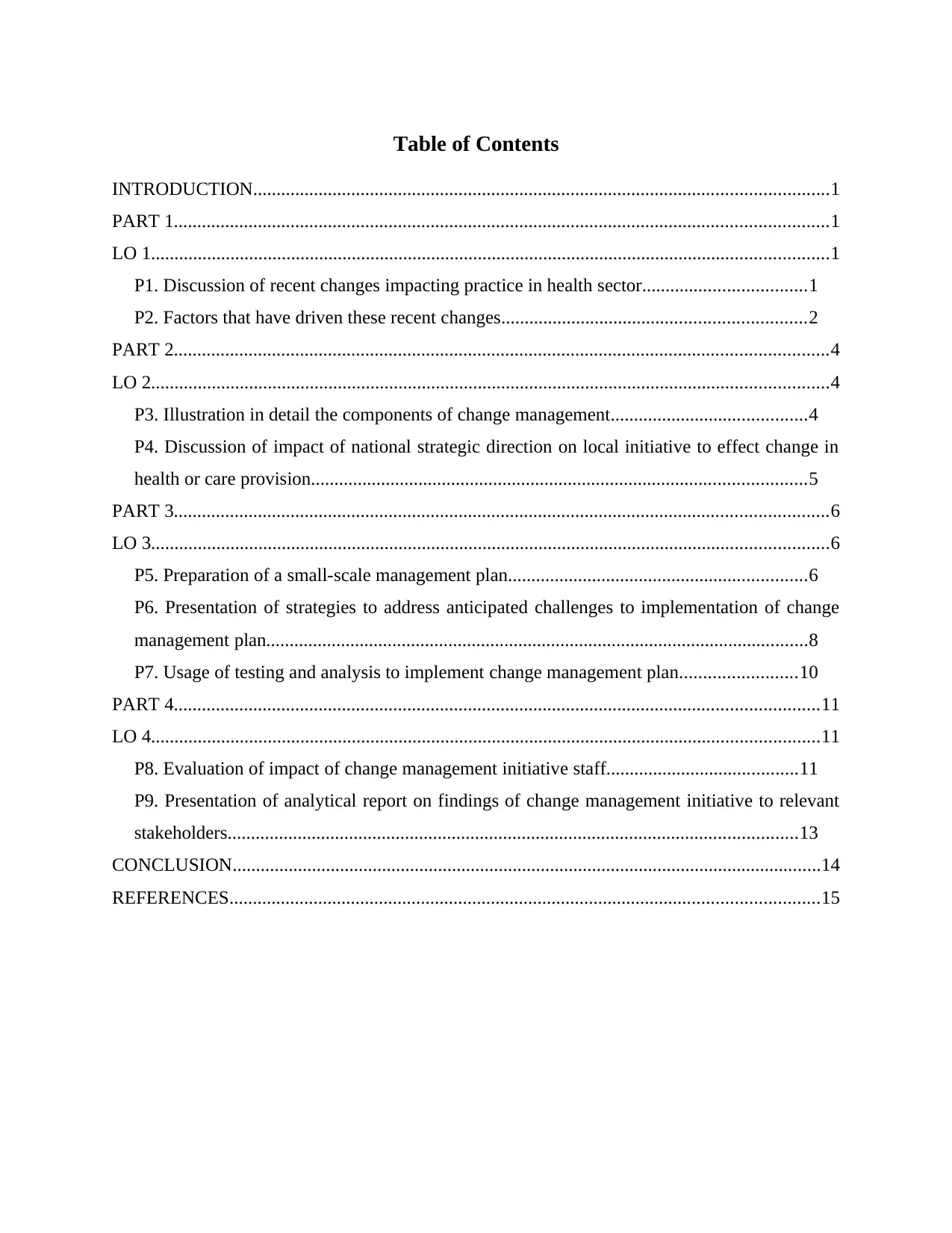
Table of Contents
INTRODUCTION...........................................................................................................................1
PART 1............................................................................................................................................1
LO 1.................................................................................................................................................1
P1. Discussion of recent changes impacting practice in health sector...................................1
P2. Factors that have driven these recent changes.................................................................2
PART 2............................................................................................................................................4
LO 2.................................................................................................................................................4
P3. Illustration in detail the components of change management..........................................4
P4. Discussion of impact of national strategic direction on local initiative to effect change in
health or care provision..........................................................................................................5
PART 3............................................................................................................................................6
LO 3.................................................................................................................................................6
P5. Preparation of a small-scale management plan................................................................6
P6. Presentation of strategies to address anticipated challenges to implementation of change
management plan....................................................................................................................8
P7. Usage of testing and analysis to implement change management plan.........................10
PART 4..........................................................................................................................................11
LO 4...............................................................................................................................................11
P8. Evaluation of impact of change management initiative staff.........................................11
P9. Presentation of analytical report on findings of change management initiative to relevant
stakeholders..........................................................................................................................13
CONCLUSION..............................................................................................................................14
REFERENCES..............................................................................................................................15
INTRODUCTION...........................................................................................................................1
PART 1............................................................................................................................................1
LO 1.................................................................................................................................................1
P1. Discussion of recent changes impacting practice in health sector...................................1
P2. Factors that have driven these recent changes.................................................................2
PART 2............................................................................................................................................4
LO 2.................................................................................................................................................4
P3. Illustration in detail the components of change management..........................................4
P4. Discussion of impact of national strategic direction on local initiative to effect change in
health or care provision..........................................................................................................5
PART 3............................................................................................................................................6
LO 3.................................................................................................................................................6
P5. Preparation of a small-scale management plan................................................................6
P6. Presentation of strategies to address anticipated challenges to implementation of change
management plan....................................................................................................................8
P7. Usage of testing and analysis to implement change management plan.........................10
PART 4..........................................................................................................................................11
LO 4...............................................................................................................................................11
P8. Evaluation of impact of change management initiative staff.........................................11
P9. Presentation of analytical report on findings of change management initiative to relevant
stakeholders..........................................................................................................................13
CONCLUSION..............................................................................................................................14
REFERENCES..............................................................................................................................15
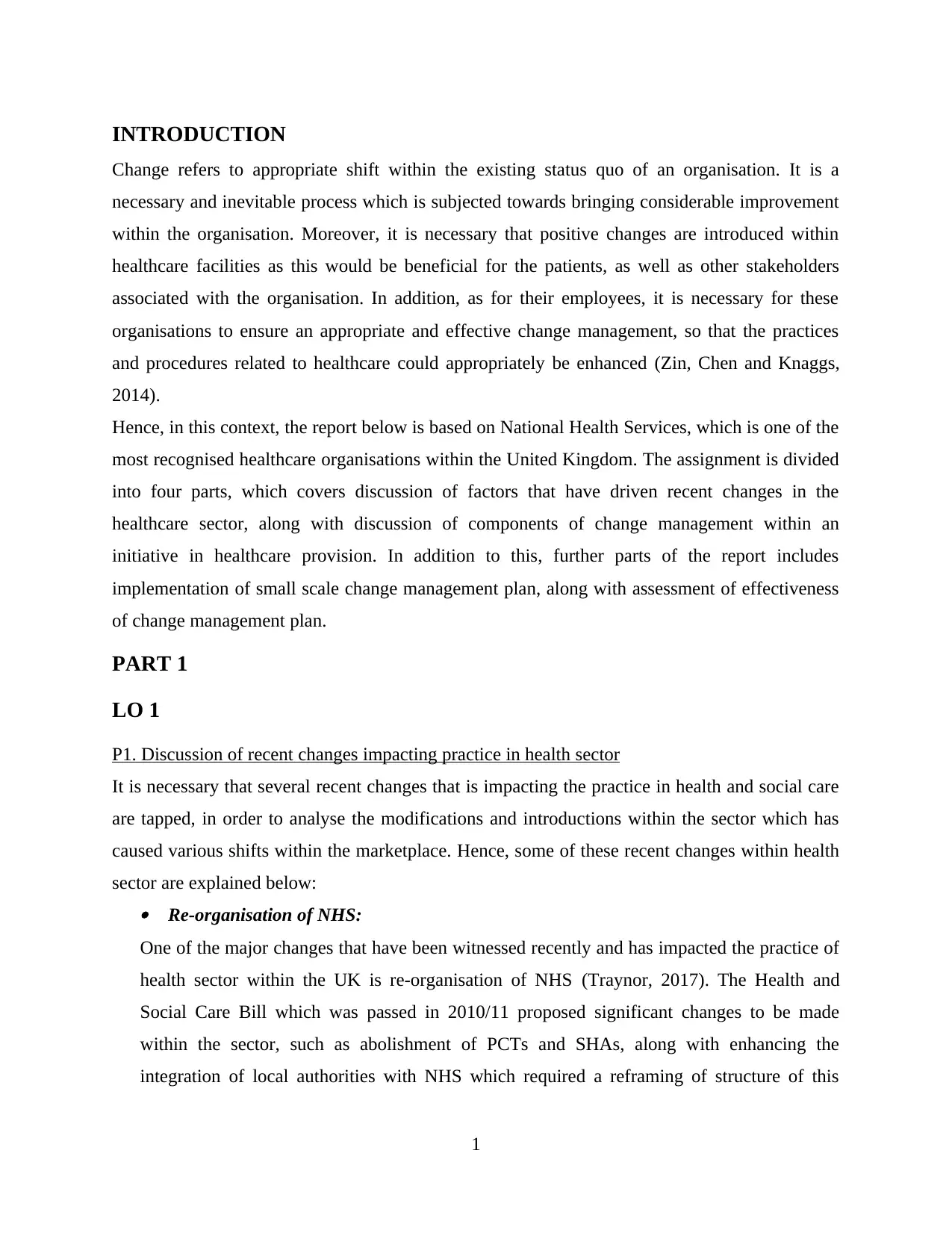
INTRODUCTION
Change refers to appropriate shift within the existing status quo of an organisation. It is a
necessary and inevitable process which is subjected towards bringing considerable improvement
within the organisation. Moreover, it is necessary that positive changes are introduced within
healthcare facilities as this would be beneficial for the patients, as well as other stakeholders
associated with the organisation. In addition, as for their employees, it is necessary for these
organisations to ensure an appropriate and effective change management, so that the practices
and procedures related to healthcare could appropriately be enhanced (Zin, Chen and Knaggs,
2014).
Hence, in this context, the report below is based on National Health Services, which is one of the
most recognised healthcare organisations within the United Kingdom. The assignment is divided
into four parts, which covers discussion of factors that have driven recent changes in the
healthcare sector, along with discussion of components of change management within an
initiative in healthcare provision. In addition to this, further parts of the report includes
implementation of small scale change management plan, along with assessment of effectiveness
of change management plan.
PART 1
LO 1
P1. Discussion of recent changes impacting practice in health sector
It is necessary that several recent changes that is impacting the practice in health and social care
are tapped, in order to analyse the modifications and introductions within the sector which has
caused various shifts within the marketplace. Hence, some of these recent changes within health
sector are explained below: Re-organisation of NHS:
One of the major changes that have been witnessed recently and has impacted the practice of
health sector within the UK is re-organisation of NHS (Traynor, 2017). The Health and
Social Care Bill which was passed in 2010/11 proposed significant changes to be made
within the sector, such as abolishment of PCTs and SHAs, along with enhancing the
integration of local authorities with NHS which required a reframing of structure of this
1
Change refers to appropriate shift within the existing status quo of an organisation. It is a
necessary and inevitable process which is subjected towards bringing considerable improvement
within the organisation. Moreover, it is necessary that positive changes are introduced within
healthcare facilities as this would be beneficial for the patients, as well as other stakeholders
associated with the organisation. In addition, as for their employees, it is necessary for these
organisations to ensure an appropriate and effective change management, so that the practices
and procedures related to healthcare could appropriately be enhanced (Zin, Chen and Knaggs,
2014).
Hence, in this context, the report below is based on National Health Services, which is one of the
most recognised healthcare organisations within the United Kingdom. The assignment is divided
into four parts, which covers discussion of factors that have driven recent changes in the
healthcare sector, along with discussion of components of change management within an
initiative in healthcare provision. In addition to this, further parts of the report includes
implementation of small scale change management plan, along with assessment of effectiveness
of change management plan.
PART 1
LO 1
P1. Discussion of recent changes impacting practice in health sector
It is necessary that several recent changes that is impacting the practice in health and social care
are tapped, in order to analyse the modifications and introductions within the sector which has
caused various shifts within the marketplace. Hence, some of these recent changes within health
sector are explained below: Re-organisation of NHS:
One of the major changes that have been witnessed recently and has impacted the practice of
health sector within the UK is re-organisation of NHS (Traynor, 2017). The Health and
Social Care Bill which was passed in 2010/11 proposed significant changes to be made
within the sector, such as abolishment of PCTs and SHAs, along with enhancing the
integration of local authorities with NHS which required a reframing of structure of this
1
⊘ This is a preview!⊘
Do you want full access?
Subscribe today to unlock all pages.

Trusted by 1+ million students worldwide
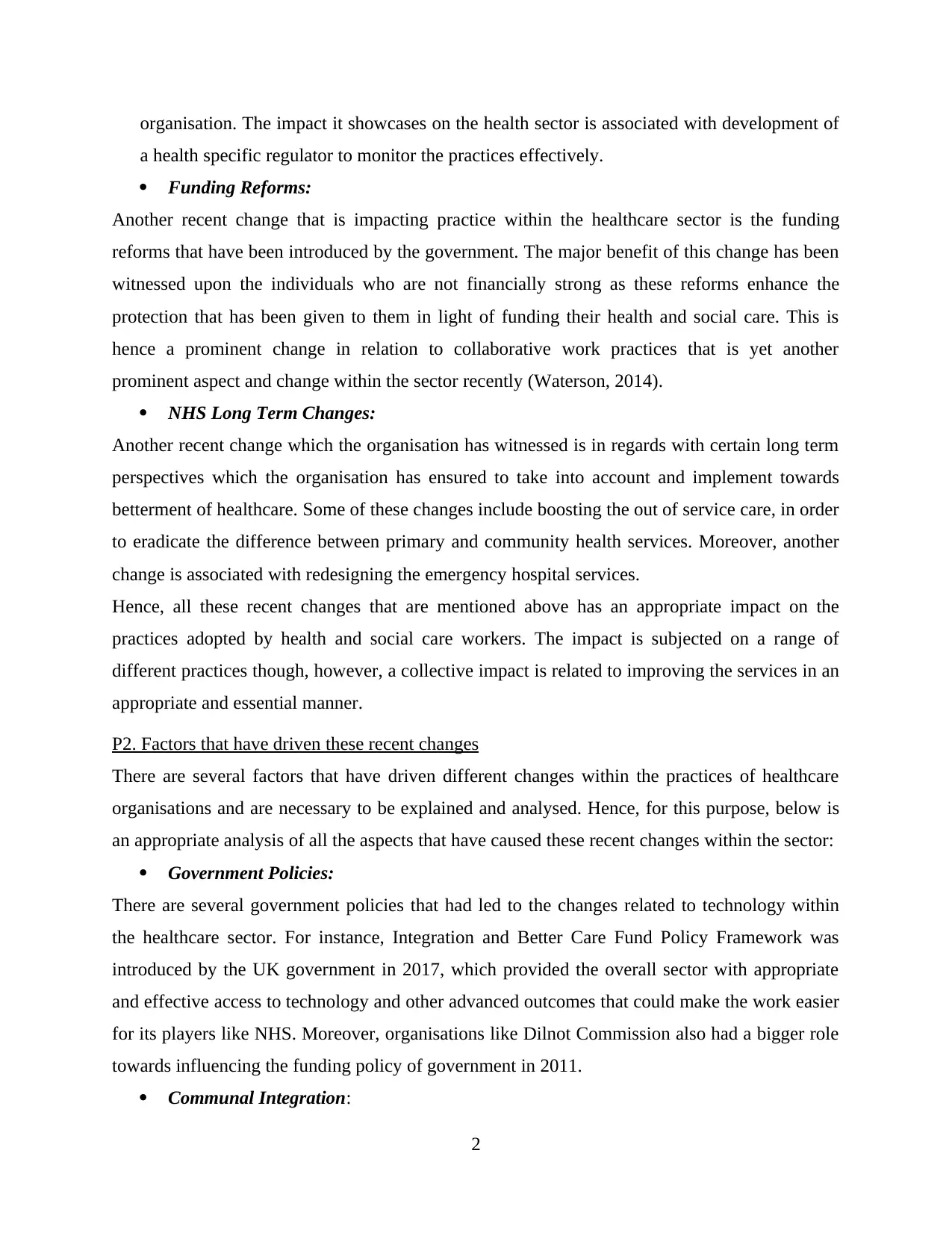
organisation. The impact it showcases on the health sector is associated with development of
a health specific regulator to monitor the practices effectively.
Funding Reforms:
Another recent change that is impacting practice within the healthcare sector is the funding
reforms that have been introduced by the government. The major benefit of this change has been
witnessed upon the individuals who are not financially strong as these reforms enhance the
protection that has been given to them in light of funding their health and social care. This is
hence a prominent change in relation to collaborative work practices that is yet another
prominent aspect and change within the sector recently (Waterson, 2014).
NHS Long Term Changes:
Another recent change which the organisation has witnessed is in regards with certain long term
perspectives which the organisation has ensured to take into account and implement towards
betterment of healthcare. Some of these changes include boosting the out of service care, in order
to eradicate the difference between primary and community health services. Moreover, another
change is associated with redesigning the emergency hospital services.
Hence, all these recent changes that are mentioned above has an appropriate impact on the
practices adopted by health and social care workers. The impact is subjected on a range of
different practices though, however, a collective impact is related to improving the services in an
appropriate and essential manner.
P2. Factors that have driven these recent changes
There are several factors that have driven different changes within the practices of healthcare
organisations and are necessary to be explained and analysed. Hence, for this purpose, below is
an appropriate analysis of all the aspects that have caused these recent changes within the sector:
Government Policies:
There are several government policies that had led to the changes related to technology within
the healthcare sector. For instance, Integration and Better Care Fund Policy Framework was
introduced by the UK government in 2017, which provided the overall sector with appropriate
and effective access to technology and other advanced outcomes that could make the work easier
for its players like NHS. Moreover, organisations like Dilnot Commission also had a bigger role
towards influencing the funding policy of government in 2011.
Communal Integration:
2
a health specific regulator to monitor the practices effectively.
Funding Reforms:
Another recent change that is impacting practice within the healthcare sector is the funding
reforms that have been introduced by the government. The major benefit of this change has been
witnessed upon the individuals who are not financially strong as these reforms enhance the
protection that has been given to them in light of funding their health and social care. This is
hence a prominent change in relation to collaborative work practices that is yet another
prominent aspect and change within the sector recently (Waterson, 2014).
NHS Long Term Changes:
Another recent change which the organisation has witnessed is in regards with certain long term
perspectives which the organisation has ensured to take into account and implement towards
betterment of healthcare. Some of these changes include boosting the out of service care, in order
to eradicate the difference between primary and community health services. Moreover, another
change is associated with redesigning the emergency hospital services.
Hence, all these recent changes that are mentioned above has an appropriate impact on the
practices adopted by health and social care workers. The impact is subjected on a range of
different practices though, however, a collective impact is related to improving the services in an
appropriate and essential manner.
P2. Factors that have driven these recent changes
There are several factors that have driven different changes within the practices of healthcare
organisations and are necessary to be explained and analysed. Hence, for this purpose, below is
an appropriate analysis of all the aspects that have caused these recent changes within the sector:
Government Policies:
There are several government policies that had led to the changes related to technology within
the healthcare sector. For instance, Integration and Better Care Fund Policy Framework was
introduced by the UK government in 2017, which provided the overall sector with appropriate
and effective access to technology and other advanced outcomes that could make the work easier
for its players like NHS. Moreover, organisations like Dilnot Commission also had a bigger role
towards influencing the funding policy of government in 2011.
Communal Integration:
2
Paraphrase This Document
Need a fresh take? Get an instant paraphrase of this document with our AI Paraphraser

There is a strong integration of community that is witnessed within the health and social care
sector quite recently. Hence, this has engaged the companies into providing a care that is
collaborative and ensures an appropriate inclusion of the peers, family members and other
essential individuals of the community that could assist the professionals into providing best care
to the patients within the care facility (Blake and Lloyd, 2020).
High Cost:
There have usually been high costs involved for individuals for individuals who wish to perform
from the organisation. Hence, this factor paved way for patient centric care within the healthcare
possibilities. This allows the organisations to focus on the patient's needs and limitations and
provide an overall effective care to them in an appropriate manner.
Brexit:
One of the biggest factors that have led to several changes in the health sector of the UK is
Brexit. The reason for this is because the changes in regulation and the transition period has
caused a major slowdown in terms of economy within the country, requiring organisations like
NHS to take further initiatives to ease the access of healthcare in the country, which would
further be enhancing their application of the long term plans, which includes effective integration
of healthcare resources, as well as arrangement of funds for people of the country for better and
more effective acquisition of healthcare.
Competition:
Healthcare is one of the most diverse sectors within the United Kingdom, with a range of private,
as well as public level organisations within the nation. Hence, there are various private level
healthcare organisations that were gaining much preferences due to their state of art techniques
and better access to facilities, which is one of the crucial determinants towards the reorganisation
of the NHS.
It is necessary to analyse the impact of these factors on the individuals accessing the services
within the organisation. In relation to the government policies, they positively influence the
patients in context of acquiring high end technologically sound services. In relation to communal
integration, it allows the individuals to build a care network to support them through their
illnesses. However, a negative factor that has been imposed on the individuals is related to high
cost, which used to refrain the individuals from adopting for best medical healthcare within the
organisation.
3
sector quite recently. Hence, this has engaged the companies into providing a care that is
collaborative and ensures an appropriate inclusion of the peers, family members and other
essential individuals of the community that could assist the professionals into providing best care
to the patients within the care facility (Blake and Lloyd, 2020).
High Cost:
There have usually been high costs involved for individuals for individuals who wish to perform
from the organisation. Hence, this factor paved way for patient centric care within the healthcare
possibilities. This allows the organisations to focus on the patient's needs and limitations and
provide an overall effective care to them in an appropriate manner.
Brexit:
One of the biggest factors that have led to several changes in the health sector of the UK is
Brexit. The reason for this is because the changes in regulation and the transition period has
caused a major slowdown in terms of economy within the country, requiring organisations like
NHS to take further initiatives to ease the access of healthcare in the country, which would
further be enhancing their application of the long term plans, which includes effective integration
of healthcare resources, as well as arrangement of funds for people of the country for better and
more effective acquisition of healthcare.
Competition:
Healthcare is one of the most diverse sectors within the United Kingdom, with a range of private,
as well as public level organisations within the nation. Hence, there are various private level
healthcare organisations that were gaining much preferences due to their state of art techniques
and better access to facilities, which is one of the crucial determinants towards the reorganisation
of the NHS.
It is necessary to analyse the impact of these factors on the individuals accessing the services
within the organisation. In relation to the government policies, they positively influence the
patients in context of acquiring high end technologically sound services. In relation to communal
integration, it allows the individuals to build a care network to support them through their
illnesses. However, a negative factor that has been imposed on the individuals is related to high
cost, which used to refrain the individuals from adopting for best medical healthcare within the
organisation.
3
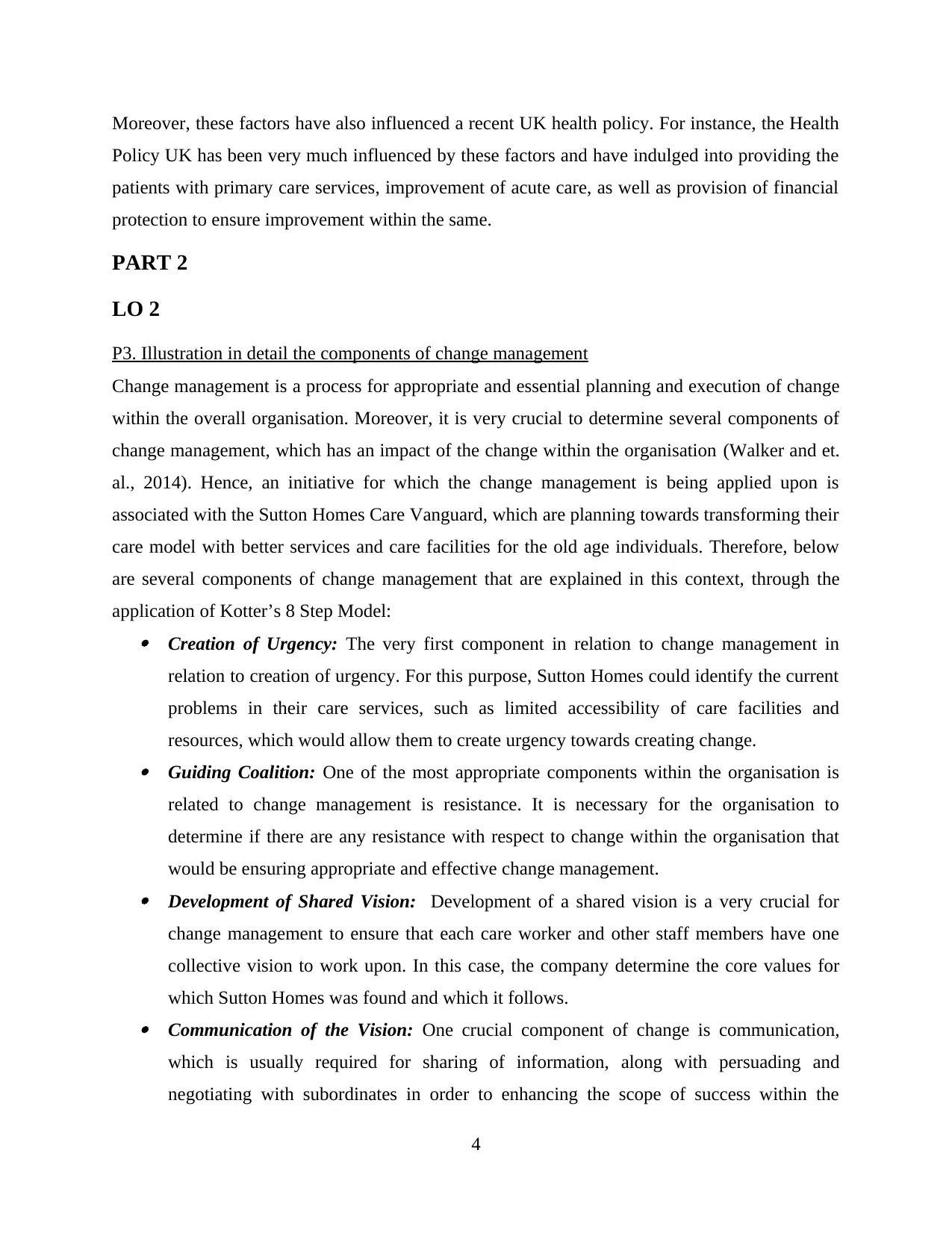
Moreover, these factors have also influenced a recent UK health policy. For instance, the Health
Policy UK has been very much influenced by these factors and have indulged into providing the
patients with primary care services, improvement of acute care, as well as provision of financial
protection to ensure improvement within the same.
PART 2
LO 2
P3. Illustration in detail the components of change management
Change management is a process for appropriate and essential planning and execution of change
within the overall organisation. Moreover, it is very crucial to determine several components of
change management, which has an impact of the change within the organisation (Walker and et.
al., 2014). Hence, an initiative for which the change management is being applied upon is
associated with the Sutton Homes Care Vanguard, which are planning towards transforming their
care model with better services and care facilities for the old age individuals. Therefore, below
are several components of change management that are explained in this context, through the
application of Kotter’s 8 Step Model: Creation of Urgency: The very first component in relation to change management in
relation to creation of urgency. For this purpose, Sutton Homes could identify the current
problems in their care services, such as limited accessibility of care facilities and
resources, which would allow them to create urgency towards creating change. Guiding Coalition: One of the most appropriate components within the organisation is
related to change management is resistance. It is necessary for the organisation to
determine if there are any resistance with respect to change within the organisation that
would be ensuring appropriate and effective change management. Development of Shared Vision: Development of a shared vision is a very crucial for
change management to ensure that each care worker and other staff members have one
collective vision to work upon. In this case, the company determine the core values for
which Sutton Homes was found and which it follows. Communication of the Vision: One crucial component of change is communication,
which is usually required for sharing of information, along with persuading and
negotiating with subordinates in order to enhancing the scope of success within the
4
Policy UK has been very much influenced by these factors and have indulged into providing the
patients with primary care services, improvement of acute care, as well as provision of financial
protection to ensure improvement within the same.
PART 2
LO 2
P3. Illustration in detail the components of change management
Change management is a process for appropriate and essential planning and execution of change
within the overall organisation. Moreover, it is very crucial to determine several components of
change management, which has an impact of the change within the organisation (Walker and et.
al., 2014). Hence, an initiative for which the change management is being applied upon is
associated with the Sutton Homes Care Vanguard, which are planning towards transforming their
care model with better services and care facilities for the old age individuals. Therefore, below
are several components of change management that are explained in this context, through the
application of Kotter’s 8 Step Model: Creation of Urgency: The very first component in relation to change management in
relation to creation of urgency. For this purpose, Sutton Homes could identify the current
problems in their care services, such as limited accessibility of care facilities and
resources, which would allow them to create urgency towards creating change. Guiding Coalition: One of the most appropriate components within the organisation is
related to change management is resistance. It is necessary for the organisation to
determine if there are any resistance with respect to change within the organisation that
would be ensuring appropriate and effective change management. Development of Shared Vision: Development of a shared vision is a very crucial for
change management to ensure that each care worker and other staff members have one
collective vision to work upon. In this case, the company determine the core values for
which Sutton Homes was found and which it follows. Communication of the Vision: One crucial component of change is communication,
which is usually required for sharing of information, along with persuading and
negotiating with subordinates in order to enhancing the scope of success within the
4
⊘ This is a preview!⊘
Do you want full access?
Subscribe today to unlock all pages.

Trusted by 1+ million students worldwide
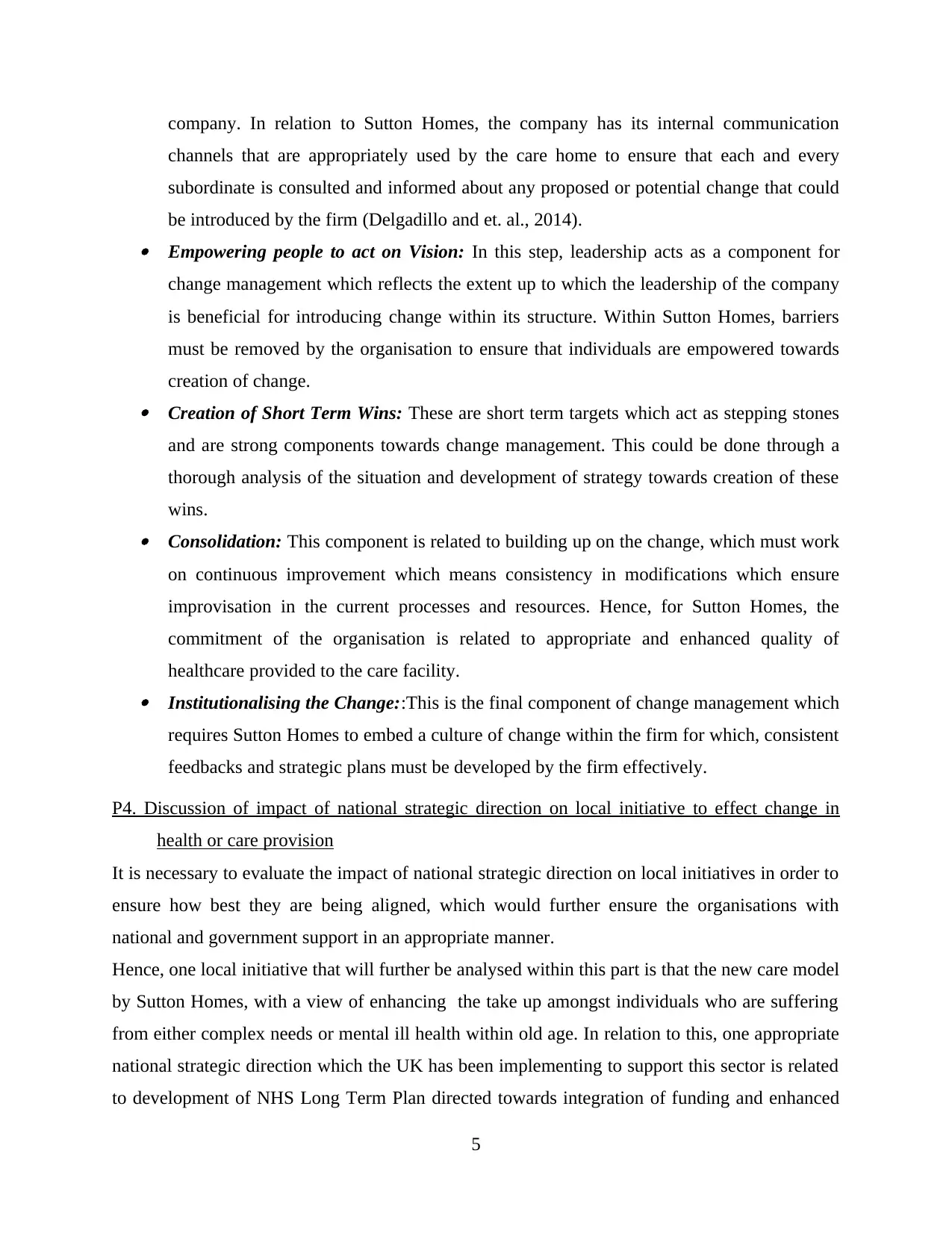
company. In relation to Sutton Homes, the company has its internal communication
channels that are appropriately used by the care home to ensure that each and every
subordinate is consulted and informed about any proposed or potential change that could
be introduced by the firm (Delgadillo and et. al., 2014). Empowering people to act on Vision: In this step, leadership acts as a component for
change management which reflects the extent up to which the leadership of the company
is beneficial for introducing change within its structure. Within Sutton Homes, barriers
must be removed by the organisation to ensure that individuals are empowered towards
creation of change. Creation of Short Term Wins: These are short term targets which act as stepping stones
and are strong components towards change management. This could be done through a
thorough analysis of the situation and development of strategy towards creation of these
wins. Consolidation: This component is related to building up on the change, which must work
on continuous improvement which means consistency in modifications which ensure
improvisation in the current processes and resources. Hence, for Sutton Homes, the
commitment of the organisation is related to appropriate and enhanced quality of
healthcare provided to the care facility. Institutionalising the Change::This is the final component of change management which
requires Sutton Homes to embed a culture of change within the firm for which, consistent
feedbacks and strategic plans must be developed by the firm effectively.
P4. Discussion of impact of national strategic direction on local initiative to effect change in
health or care provision
It is necessary to evaluate the impact of national strategic direction on local initiatives in order to
ensure how best they are being aligned, which would further ensure the organisations with
national and government support in an appropriate manner.
Hence, one local initiative that will further be analysed within this part is that the new care model
by Sutton Homes, with a view of enhancing the take up amongst individuals who are suffering
from either complex needs or mental ill health within old age. In relation to this, one appropriate
national strategic direction which the UK has been implementing to support this sector is related
to development of NHS Long Term Plan directed towards integration of funding and enhanced
5
channels that are appropriately used by the care home to ensure that each and every
subordinate is consulted and informed about any proposed or potential change that could
be introduced by the firm (Delgadillo and et. al., 2014). Empowering people to act on Vision: In this step, leadership acts as a component for
change management which reflects the extent up to which the leadership of the company
is beneficial for introducing change within its structure. Within Sutton Homes, barriers
must be removed by the organisation to ensure that individuals are empowered towards
creation of change. Creation of Short Term Wins: These are short term targets which act as stepping stones
and are strong components towards change management. This could be done through a
thorough analysis of the situation and development of strategy towards creation of these
wins. Consolidation: This component is related to building up on the change, which must work
on continuous improvement which means consistency in modifications which ensure
improvisation in the current processes and resources. Hence, for Sutton Homes, the
commitment of the organisation is related to appropriate and enhanced quality of
healthcare provided to the care facility. Institutionalising the Change::This is the final component of change management which
requires Sutton Homes to embed a culture of change within the firm for which, consistent
feedbacks and strategic plans must be developed by the firm effectively.
P4. Discussion of impact of national strategic direction on local initiative to effect change in
health or care provision
It is necessary to evaluate the impact of national strategic direction on local initiatives in order to
ensure how best they are being aligned, which would further ensure the organisations with
national and government support in an appropriate manner.
Hence, one local initiative that will further be analysed within this part is that the new care model
by Sutton Homes, with a view of enhancing the take up amongst individuals who are suffering
from either complex needs or mental ill health within old age. In relation to this, one appropriate
national strategic direction which the UK has been implementing to support this sector is related
to development of NHS Long Term Plan directed towards integration of funding and enhanced
5
Paraphrase This Document
Need a fresh take? Get an instant paraphrase of this document with our AI Paraphraser
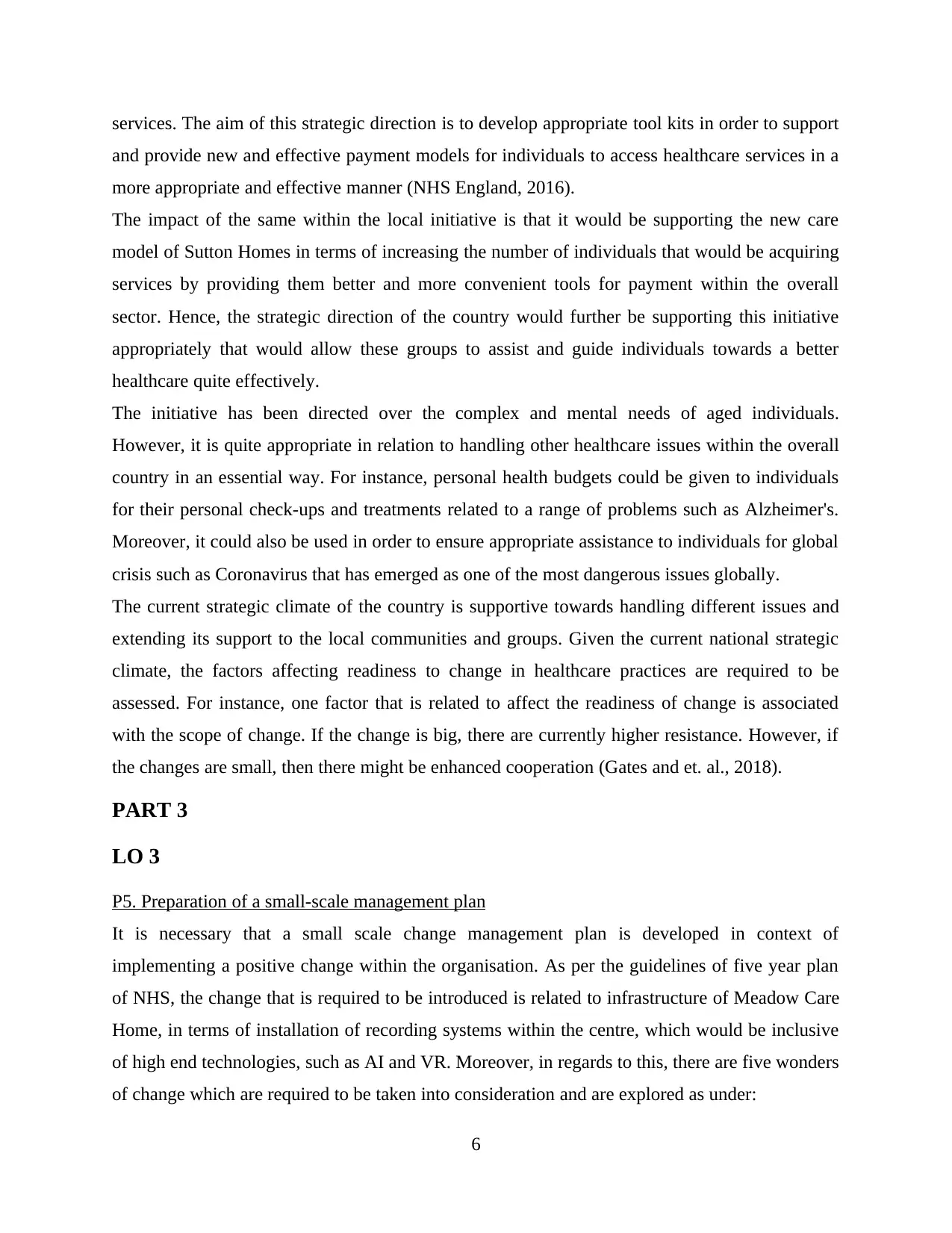
services. The aim of this strategic direction is to develop appropriate tool kits in order to support
and provide new and effective payment models for individuals to access healthcare services in a
more appropriate and effective manner (NHS England, 2016).
The impact of the same within the local initiative is that it would be supporting the new care
model of Sutton Homes in terms of increasing the number of individuals that would be acquiring
services by providing them better and more convenient tools for payment within the overall
sector. Hence, the strategic direction of the country would further be supporting this initiative
appropriately that would allow these groups to assist and guide individuals towards a better
healthcare quite effectively.
The initiative has been directed over the complex and mental needs of aged individuals.
However, it is quite appropriate in relation to handling other healthcare issues within the overall
country in an essential way. For instance, personal health budgets could be given to individuals
for their personal check-ups and treatments related to a range of problems such as Alzheimer's.
Moreover, it could also be used in order to ensure appropriate assistance to individuals for global
crisis such as Coronavirus that has emerged as one of the most dangerous issues globally.
The current strategic climate of the country is supportive towards handling different issues and
extending its support to the local communities and groups. Given the current national strategic
climate, the factors affecting readiness to change in healthcare practices are required to be
assessed. For instance, one factor that is related to affect the readiness of change is associated
with the scope of change. If the change is big, there are currently higher resistance. However, if
the changes are small, then there might be enhanced cooperation (Gates and et. al., 2018).
PART 3
LO 3
P5. Preparation of a small-scale management plan
It is necessary that a small scale change management plan is developed in context of
implementing a positive change within the organisation. As per the guidelines of five year plan
of NHS, the change that is required to be introduced is related to infrastructure of Meadow Care
Home, in terms of installation of recording systems within the centre, which would be inclusive
of high end technologies, such as AI and VR. Moreover, in regards to this, there are five wonders
of change which are required to be taken into consideration and are explored as under:
6
and provide new and effective payment models for individuals to access healthcare services in a
more appropriate and effective manner (NHS England, 2016).
The impact of the same within the local initiative is that it would be supporting the new care
model of Sutton Homes in terms of increasing the number of individuals that would be acquiring
services by providing them better and more convenient tools for payment within the overall
sector. Hence, the strategic direction of the country would further be supporting this initiative
appropriately that would allow these groups to assist and guide individuals towards a better
healthcare quite effectively.
The initiative has been directed over the complex and mental needs of aged individuals.
However, it is quite appropriate in relation to handling other healthcare issues within the overall
country in an essential way. For instance, personal health budgets could be given to individuals
for their personal check-ups and treatments related to a range of problems such as Alzheimer's.
Moreover, it could also be used in order to ensure appropriate assistance to individuals for global
crisis such as Coronavirus that has emerged as one of the most dangerous issues globally.
The current strategic climate of the country is supportive towards handling different issues and
extending its support to the local communities and groups. Given the current national strategic
climate, the factors affecting readiness to change in healthcare practices are required to be
assessed. For instance, one factor that is related to affect the readiness of change is associated
with the scope of change. If the change is big, there are currently higher resistance. However, if
the changes are small, then there might be enhanced cooperation (Gates and et. al., 2018).
PART 3
LO 3
P5. Preparation of a small-scale management plan
It is necessary that a small scale change management plan is developed in context of
implementing a positive change within the organisation. As per the guidelines of five year plan
of NHS, the change that is required to be introduced is related to infrastructure of Meadow Care
Home, in terms of installation of recording systems within the centre, which would be inclusive
of high end technologies, such as AI and VR. Moreover, in regards to this, there are five wonders
of change which are required to be taken into consideration and are explored as under:
6
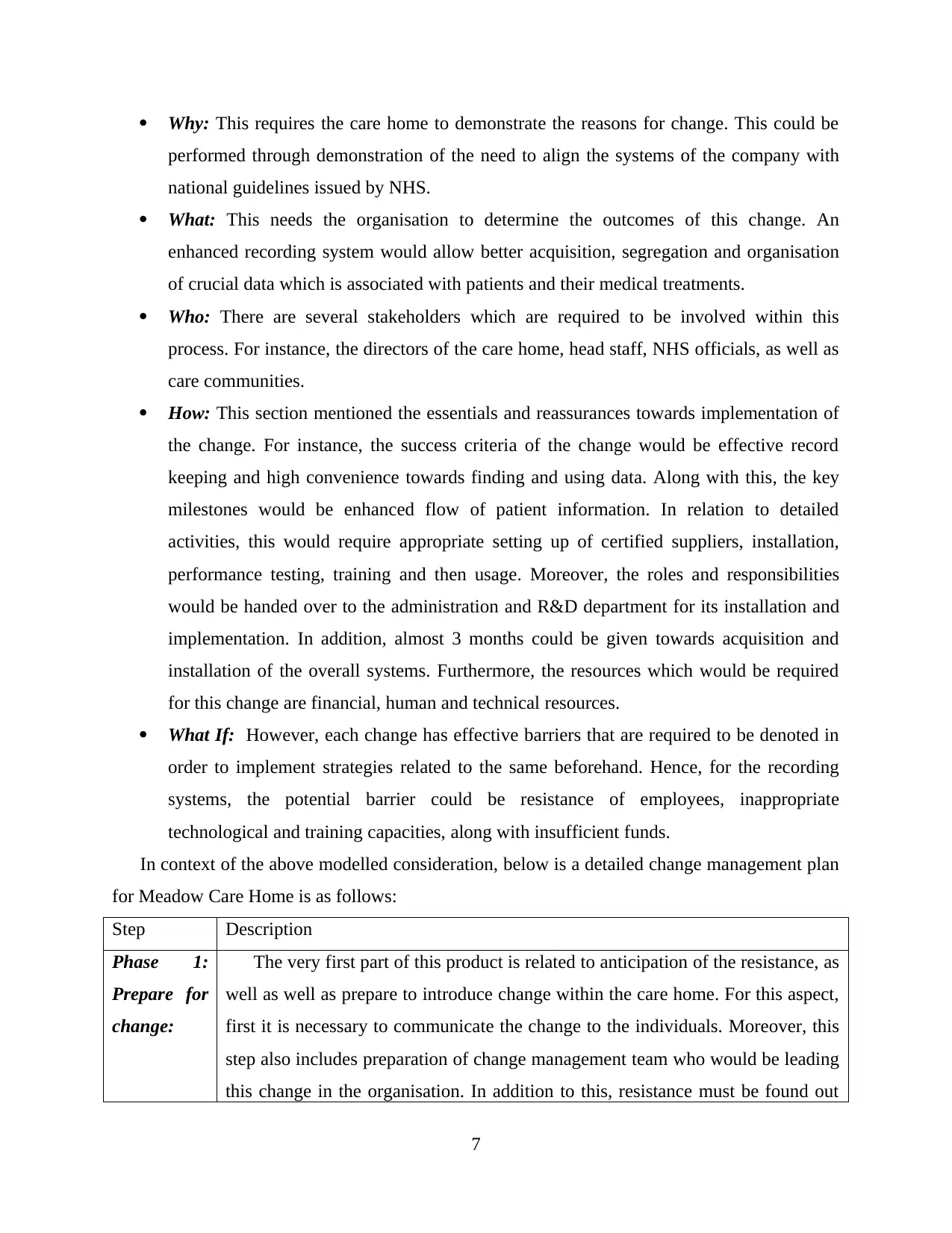
Why: This requires the care home to demonstrate the reasons for change. This could be
performed through demonstration of the need to align the systems of the company with
national guidelines issued by NHS.
What: This needs the organisation to determine the outcomes of this change. An
enhanced recording system would allow better acquisition, segregation and organisation
of crucial data which is associated with patients and their medical treatments.
Who: There are several stakeholders which are required to be involved within this
process. For instance, the directors of the care home, head staff, NHS officials, as well as
care communities.
How: This section mentioned the essentials and reassurances towards implementation of
the change. For instance, the success criteria of the change would be effective record
keeping and high convenience towards finding and using data. Along with this, the key
milestones would be enhanced flow of patient information. In relation to detailed
activities, this would require appropriate setting up of certified suppliers, installation,
performance testing, training and then usage. Moreover, the roles and responsibilities
would be handed over to the administration and R&D department for its installation and
implementation. In addition, almost 3 months could be given towards acquisition and
installation of the overall systems. Furthermore, the resources which would be required
for this change are financial, human and technical resources.
What If: However, each change has effective barriers that are required to be denoted in
order to implement strategies related to the same beforehand. Hence, for the recording
systems, the potential barrier could be resistance of employees, inappropriate
technological and training capacities, along with insufficient funds.
In context of the above modelled consideration, below is a detailed change management plan
for Meadow Care Home is as follows:
Step Description
Phase 1:
Prepare for
change:
The very first part of this product is related to anticipation of the resistance, as
well as well as prepare to introduce change within the care home. For this aspect,
first it is necessary to communicate the change to the individuals. Moreover, this
step also includes preparation of change management team who would be leading
this change in the organisation. In addition to this, resistance must be found out
7
performed through demonstration of the need to align the systems of the company with
national guidelines issued by NHS.
What: This needs the organisation to determine the outcomes of this change. An
enhanced recording system would allow better acquisition, segregation and organisation
of crucial data which is associated with patients and their medical treatments.
Who: There are several stakeholders which are required to be involved within this
process. For instance, the directors of the care home, head staff, NHS officials, as well as
care communities.
How: This section mentioned the essentials and reassurances towards implementation of
the change. For instance, the success criteria of the change would be effective record
keeping and high convenience towards finding and using data. Along with this, the key
milestones would be enhanced flow of patient information. In relation to detailed
activities, this would require appropriate setting up of certified suppliers, installation,
performance testing, training and then usage. Moreover, the roles and responsibilities
would be handed over to the administration and R&D department for its installation and
implementation. In addition, almost 3 months could be given towards acquisition and
installation of the overall systems. Furthermore, the resources which would be required
for this change are financial, human and technical resources.
What If: However, each change has effective barriers that are required to be denoted in
order to implement strategies related to the same beforehand. Hence, for the recording
systems, the potential barrier could be resistance of employees, inappropriate
technological and training capacities, along with insufficient funds.
In context of the above modelled consideration, below is a detailed change management plan
for Meadow Care Home is as follows:
Step Description
Phase 1:
Prepare for
change:
The very first part of this product is related to anticipation of the resistance, as
well as well as prepare to introduce change within the care home. For this aspect,
first it is necessary to communicate the change to the individuals. Moreover, this
step also includes preparation of change management team who would be leading
this change in the organisation. In addition to this, resistance must be found out
7
⊘ This is a preview!⊘
Do you want full access?
Subscribe today to unlock all pages.

Trusted by 1+ million students worldwide
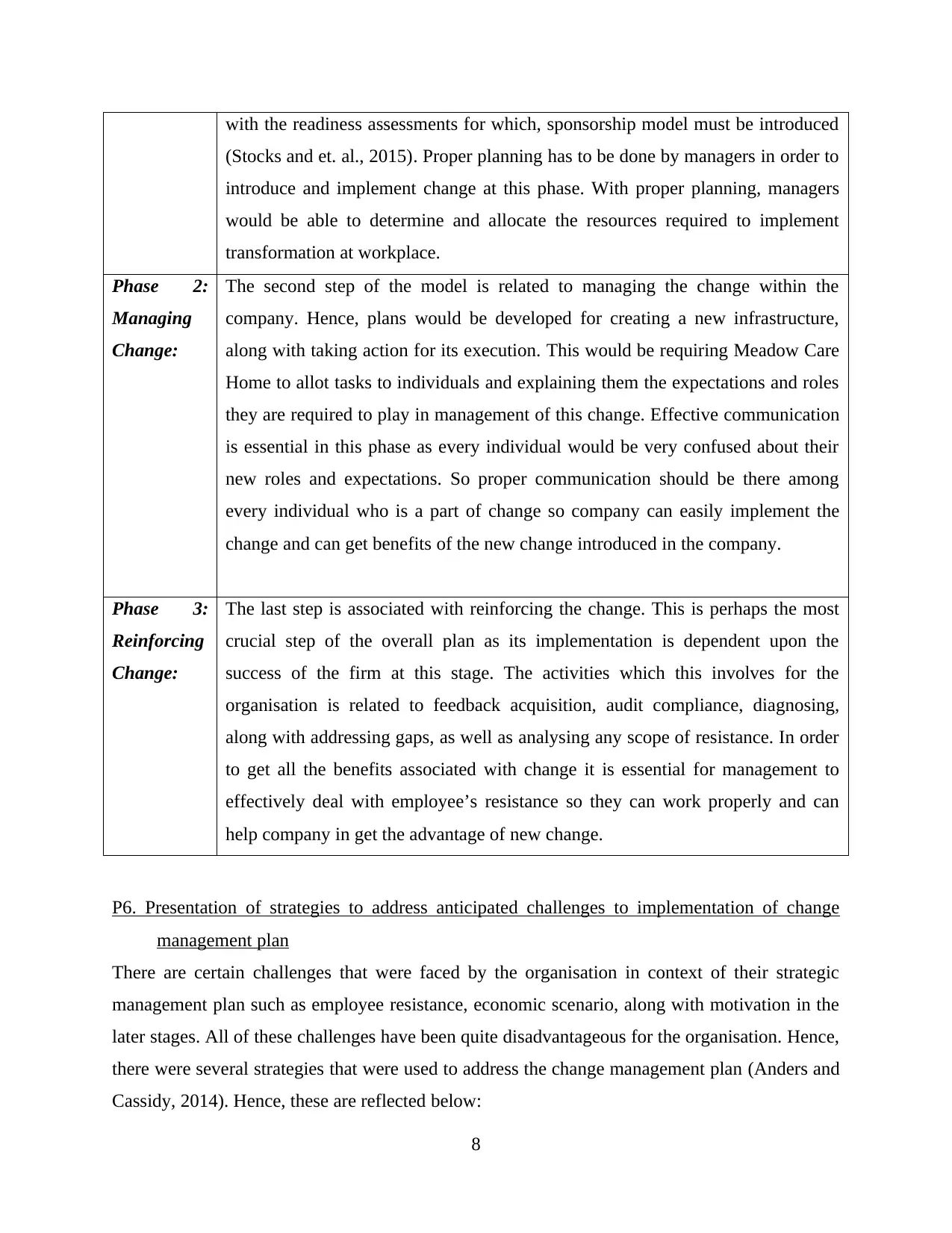
with the readiness assessments for which, sponsorship model must be introduced
(Stocks and et. al., 2015). Proper planning has to be done by managers in order to
introduce and implement change at this phase. With proper planning, managers
would be able to determine and allocate the resources required to implement
transformation at workplace.
Phase 2:
Managing
Change:
The second step of the model is related to managing the change within the
company. Hence, plans would be developed for creating a new infrastructure,
along with taking action for its execution. This would be requiring Meadow Care
Home to allot tasks to individuals and explaining them the expectations and roles
they are required to play in management of this change. Effective communication
is essential in this phase as every individual would be very confused about their
new roles and expectations. So proper communication should be there among
every individual who is a part of change so company can easily implement the
change and can get benefits of the new change introduced in the company.
Phase 3:
Reinforcing
Change:
The last step is associated with reinforcing the change. This is perhaps the most
crucial step of the overall plan as its implementation is dependent upon the
success of the firm at this stage. The activities which this involves for the
organisation is related to feedback acquisition, audit compliance, diagnosing,
along with addressing gaps, as well as analysing any scope of resistance. In order
to get all the benefits associated with change it is essential for management to
effectively deal with employee’s resistance so they can work properly and can
help company in get the advantage of new change.
P6. Presentation of strategies to address anticipated challenges to implementation of change
management plan
There are certain challenges that were faced by the organisation in context of their strategic
management plan such as employee resistance, economic scenario, along with motivation in the
later stages. All of these challenges have been quite disadvantageous for the organisation. Hence,
there were several strategies that were used to address the change management plan (Anders and
Cassidy, 2014). Hence, these are reflected below:
8
(Stocks and et. al., 2015). Proper planning has to be done by managers in order to
introduce and implement change at this phase. With proper planning, managers
would be able to determine and allocate the resources required to implement
transformation at workplace.
Phase 2:
Managing
Change:
The second step of the model is related to managing the change within the
company. Hence, plans would be developed for creating a new infrastructure,
along with taking action for its execution. This would be requiring Meadow Care
Home to allot tasks to individuals and explaining them the expectations and roles
they are required to play in management of this change. Effective communication
is essential in this phase as every individual would be very confused about their
new roles and expectations. So proper communication should be there among
every individual who is a part of change so company can easily implement the
change and can get benefits of the new change introduced in the company.
Phase 3:
Reinforcing
Change:
The last step is associated with reinforcing the change. This is perhaps the most
crucial step of the overall plan as its implementation is dependent upon the
success of the firm at this stage. The activities which this involves for the
organisation is related to feedback acquisition, audit compliance, diagnosing,
along with addressing gaps, as well as analysing any scope of resistance. In order
to get all the benefits associated with change it is essential for management to
effectively deal with employee’s resistance so they can work properly and can
help company in get the advantage of new change.
P6. Presentation of strategies to address anticipated challenges to implementation of change
management plan
There are certain challenges that were faced by the organisation in context of their strategic
management plan such as employee resistance, economic scenario, along with motivation in the
later stages. All of these challenges have been quite disadvantageous for the organisation. Hence,
there were several strategies that were used to address the change management plan (Anders and
Cassidy, 2014). Hence, these are reflected below:
8
Paraphrase This Document
Need a fresh take? Get an instant paraphrase of this document with our AI Paraphraser
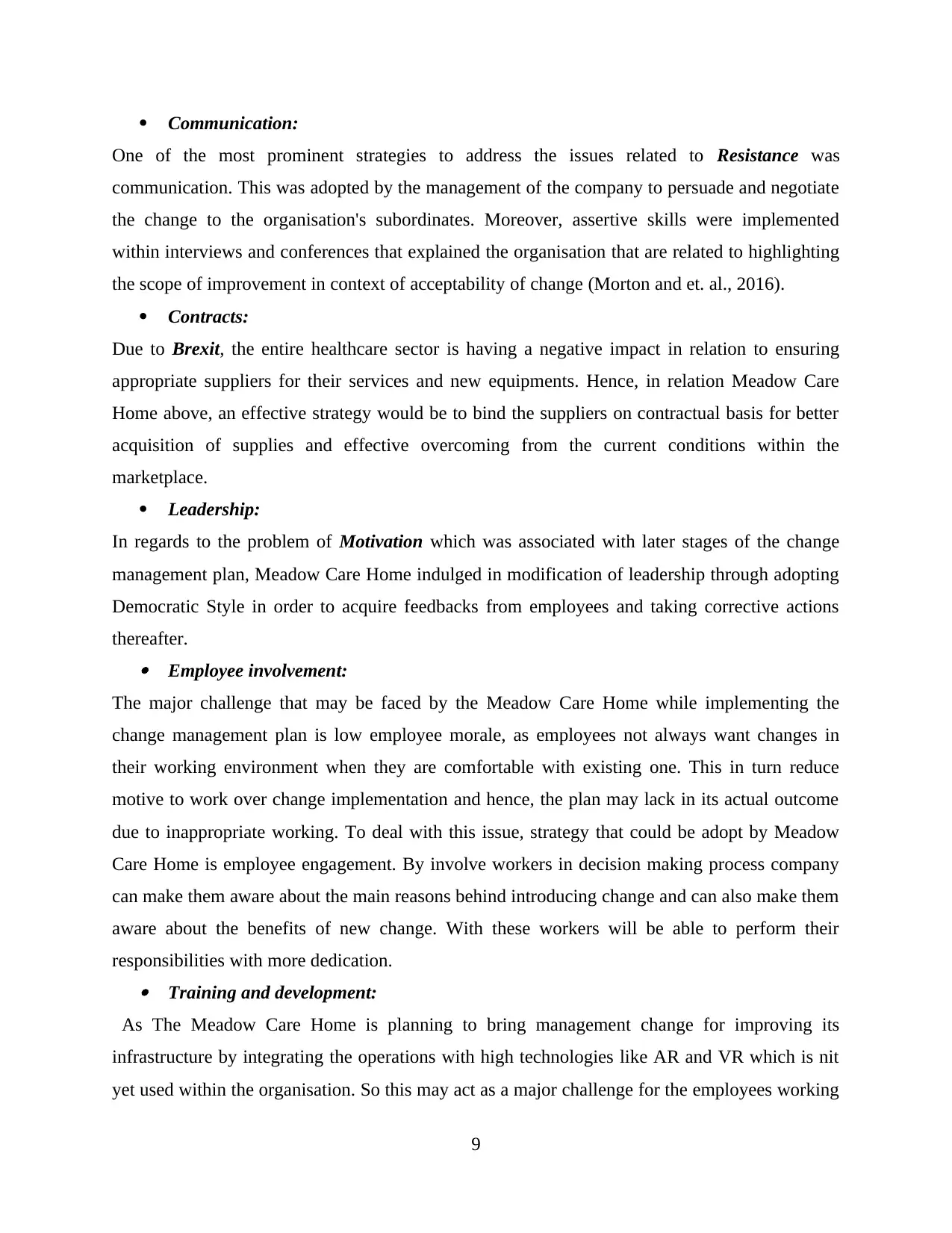
Communication:
One of the most prominent strategies to address the issues related to Resistance was
communication. This was adopted by the management of the company to persuade and negotiate
the change to the organisation's subordinates. Moreover, assertive skills were implemented
within interviews and conferences that explained the organisation that are related to highlighting
the scope of improvement in context of acceptability of change (Morton and et. al., 2016).
Contracts:
Due to Brexit, the entire healthcare sector is having a negative impact in relation to ensuring
appropriate suppliers for their services and new equipments. Hence, in relation Meadow Care
Home above, an effective strategy would be to bind the suppliers on contractual basis for better
acquisition of supplies and effective overcoming from the current conditions within the
marketplace.
Leadership:
In regards to the problem of Motivation which was associated with later stages of the change
management plan, Meadow Care Home indulged in modification of leadership through adopting
Democratic Style in order to acquire feedbacks from employees and taking corrective actions
thereafter. Employee involvement:
The major challenge that may be faced by the Meadow Care Home while implementing the
change management plan is low employee morale, as employees not always want changes in
their working environment when they are comfortable with existing one. This in turn reduce
motive to work over change implementation and hence, the plan may lack in its actual outcome
due to inappropriate working. To deal with this issue, strategy that could be adopt by Meadow
Care Home is employee engagement. By involve workers in decision making process company
can make them aware about the main reasons behind introducing change and can also make them
aware about the benefits of new change. With these workers will be able to perform their
responsibilities with more dedication. Training and development:
As The Meadow Care Home is planning to bring management change for improving its
infrastructure by integrating the operations with high technologies like AR and VR which is nit
yet used within the organisation. So this may act as a major challenge for the employees working
9
One of the most prominent strategies to address the issues related to Resistance was
communication. This was adopted by the management of the company to persuade and negotiate
the change to the organisation's subordinates. Moreover, assertive skills were implemented
within interviews and conferences that explained the organisation that are related to highlighting
the scope of improvement in context of acceptability of change (Morton and et. al., 2016).
Contracts:
Due to Brexit, the entire healthcare sector is having a negative impact in relation to ensuring
appropriate suppliers for their services and new equipments. Hence, in relation Meadow Care
Home above, an effective strategy would be to bind the suppliers on contractual basis for better
acquisition of supplies and effective overcoming from the current conditions within the
marketplace.
Leadership:
In regards to the problem of Motivation which was associated with later stages of the change
management plan, Meadow Care Home indulged in modification of leadership through adopting
Democratic Style in order to acquire feedbacks from employees and taking corrective actions
thereafter. Employee involvement:
The major challenge that may be faced by the Meadow Care Home while implementing the
change management plan is low employee morale, as employees not always want changes in
their working environment when they are comfortable with existing one. This in turn reduce
motive to work over change implementation and hence, the plan may lack in its actual outcome
due to inappropriate working. To deal with this issue, strategy that could be adopt by Meadow
Care Home is employee engagement. By involve workers in decision making process company
can make them aware about the main reasons behind introducing change and can also make them
aware about the benefits of new change. With these workers will be able to perform their
responsibilities with more dedication. Training and development:
As The Meadow Care Home is planning to bring management change for improving its
infrastructure by integrating the operations with high technologies like AR and VR which is nit
yet used within the organisation. So this may act as a major challenge for the employees working
9
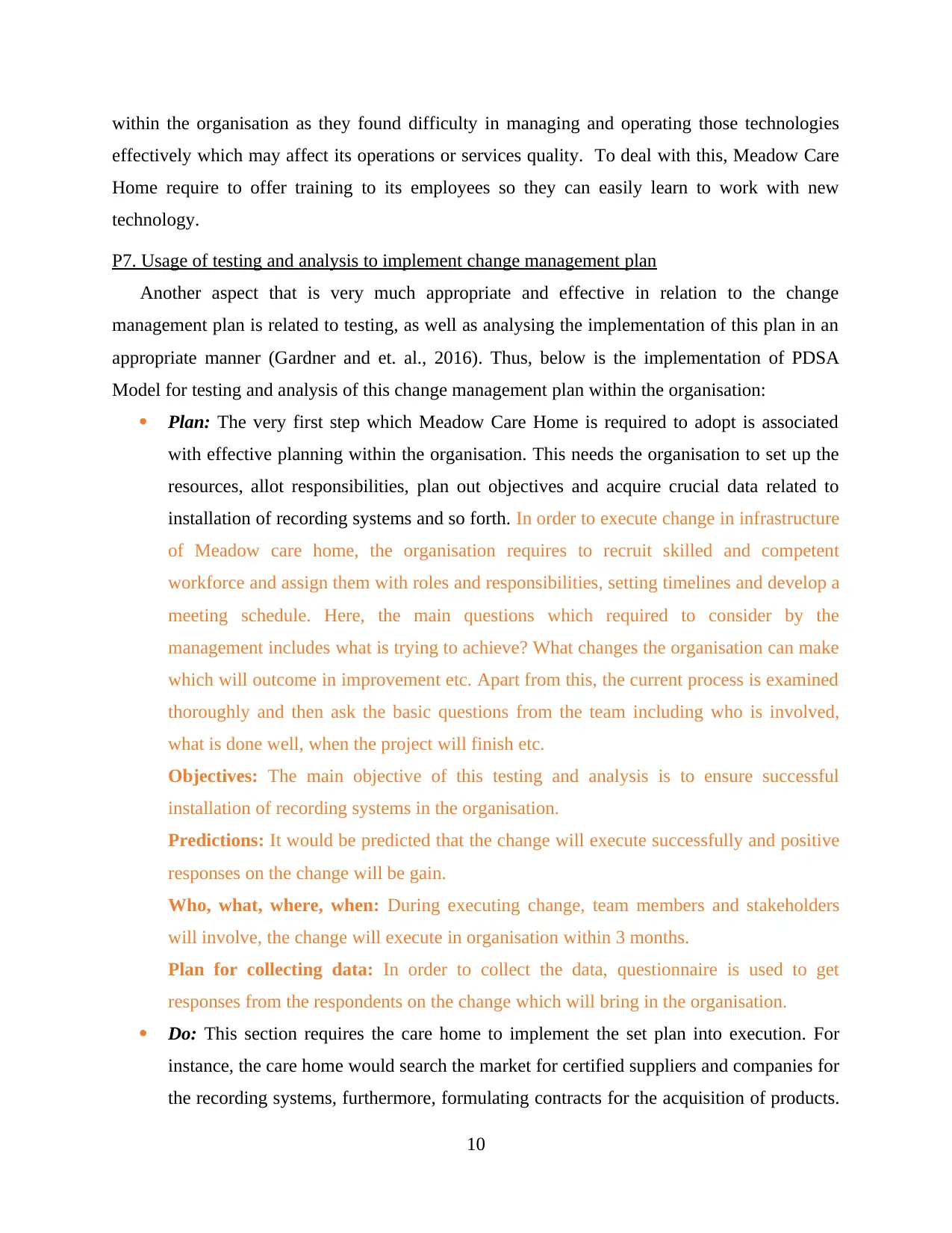
within the organisation as they found difficulty in managing and operating those technologies
effectively which may affect its operations or services quality. To deal with this, Meadow Care
Home require to offer training to its employees so they can easily learn to work with new
technology.
P7. Usage of testing and analysis to implement change management plan
Another aspect that is very much appropriate and effective in relation to the change
management plan is related to testing, as well as analysing the implementation of this plan in an
appropriate manner (Gardner and et. al., 2016). Thus, below is the implementation of PDSA
Model for testing and analysis of this change management plan within the organisation:
Plan: The very first step which Meadow Care Home is required to adopt is associated
with effective planning within the organisation. This needs the organisation to set up the
resources, allot responsibilities, plan out objectives and acquire crucial data related to
installation of recording systems and so forth. In order to execute change in infrastructure
of Meadow care home, the organisation requires to recruit skilled and competent
workforce and assign them with roles and responsibilities, setting timelines and develop a
meeting schedule. Here, the main questions which required to consider by the
management includes what is trying to achieve? What changes the organisation can make
which will outcome in improvement etc. Apart from this, the current process is examined
thoroughly and then ask the basic questions from the team including who is involved,
what is done well, when the project will finish etc.
Objectives: The main objective of this testing and analysis is to ensure successful
installation of recording systems in the organisation.
Predictions: It would be predicted that the change will execute successfully and positive
responses on the change will be gain.
Who, what, where, when: During executing change, team members and stakeholders
will involve, the change will execute in organisation within 3 months.
Plan for collecting data: In order to collect the data, questionnaire is used to get
responses from the respondents on the change which will bring in the organisation.
Do: This section requires the care home to implement the set plan into execution. For
instance, the care home would search the market for certified suppliers and companies for
the recording systems, furthermore, formulating contracts for the acquisition of products.
10
effectively which may affect its operations or services quality. To deal with this, Meadow Care
Home require to offer training to its employees so they can easily learn to work with new
technology.
P7. Usage of testing and analysis to implement change management plan
Another aspect that is very much appropriate and effective in relation to the change
management plan is related to testing, as well as analysing the implementation of this plan in an
appropriate manner (Gardner and et. al., 2016). Thus, below is the implementation of PDSA
Model for testing and analysis of this change management plan within the organisation:
Plan: The very first step which Meadow Care Home is required to adopt is associated
with effective planning within the organisation. This needs the organisation to set up the
resources, allot responsibilities, plan out objectives and acquire crucial data related to
installation of recording systems and so forth. In order to execute change in infrastructure
of Meadow care home, the organisation requires to recruit skilled and competent
workforce and assign them with roles and responsibilities, setting timelines and develop a
meeting schedule. Here, the main questions which required to consider by the
management includes what is trying to achieve? What changes the organisation can make
which will outcome in improvement etc. Apart from this, the current process is examined
thoroughly and then ask the basic questions from the team including who is involved,
what is done well, when the project will finish etc.
Objectives: The main objective of this testing and analysis is to ensure successful
installation of recording systems in the organisation.
Predictions: It would be predicted that the change will execute successfully and positive
responses on the change will be gain.
Who, what, where, when: During executing change, team members and stakeholders
will involve, the change will execute in organisation within 3 months.
Plan for collecting data: In order to collect the data, questionnaire is used to get
responses from the respondents on the change which will bring in the organisation.
Do: This section requires the care home to implement the set plan into execution. For
instance, the care home would search the market for certified suppliers and companies for
the recording systems, furthermore, formulating contracts for the acquisition of products.
10
⊘ This is a preview!⊘
Do you want full access?
Subscribe today to unlock all pages.

Trusted by 1+ million students worldwide
1 out of 20
Related Documents
Your All-in-One AI-Powered Toolkit for Academic Success.
+13062052269
info@desklib.com
Available 24*7 on WhatsApp / Email
![[object Object]](/_next/static/media/star-bottom.7253800d.svg)
Unlock your academic potential
Copyright © 2020–2025 A2Z Services. All Rights Reserved. Developed and managed by ZUCOL.





